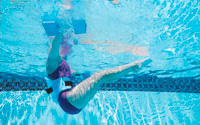AquaJogger® – Start Water Fitness Today
Water fitness is one of the fastest growing workouts today. Here is a step by step guide to help you add pool running to your fitness program.

Find a pool for Water Fitness
A growing number of pools are establishing lanes for water fitness. The use of a hitch or leash (a bungie cord with special hook fasteners available from AquaJogger) is a great choice when working out in a lap lane with swimmers. Simply go to the deep end of the slowest lane and hitch up to the lane divider outlet in the pool wall. Because you are in a vertical position you will be using only a small amount of the pool surface compared to the lap swimmers. In addition, an AquaHitch can help you stay focused, increase resistance (by pulling you back as you attempt to advance forward) and it creates a sense of territory in the crowded pool. Also, check to see if your local facilities have a diving well. These are usually under-used portions of the pool facility and often have space open for pool running. The needs of the pool runner can also be accomodated during the pool’s off-hours.”
Establish Fitness Goals
Every time you enter the pool you should have an established goal for the day- a recovery run, low or high intensity workout or an interval session.
Wear Water Fitness Flotation Equipment
Wearing the Original AquaJogger Buoyancy Belt will keep your head above water, support your lower back and give you the freedom to duplicate your running form. Water fitness specialist David Brennan, President of Houston Intl. Running Center, discourages deep water fitness without a good flotation device, since correct form is almost impossible to maintain for any length of time without one. The water line should be at the shoulder level, and your mouth comfortably out of the water without having to tilt your head. For additional resistance you can add foam footwear such as AquaRunners or DeltaBells hand-held resistance (both available from AquaJogger).
Use Proper Technique in Water
Good posture is crucial. Brennan suggests the following technique and tips for water runners: “Keep your eyes looking ahead of you, not down. Don’t lean forward. Aqua running is done in a near vertical position. Move your arms close to your body, thumbs on top, hand lightly cupped with thumbs traveling back and forth from the chest to hips. Stride angle of the thigh should reach about 80 degrees and toes should not be pointed. You want to replicate the road running motion as much as possible.”
Structure a Water Workout
Ease into water fitness. Begin each session with 5-10 minutes of very light to medium exercise. Follow the warm up with 25-45 minutes of training. One continuous run may be too ambitious at first. If so, break up the half-hour into segments of 2 or 3 minutes with 30-second rest breaks. Eventually, you can aim for an hour of continuous running and speed workouts that consist of several 1-minute repetitions. End each session with some very light exercises and stretches. As you gain experience, build both speed and duration.
Monitor Your Water Fitness Progress
Pay attention to how your body feels during water workouts, how stressed it becomes. A few pieces of equipment can make this very easy to do. The following are helpful: a waterproof stopwatch or a pool side clock to time each workout. A waterproof wireless heart rate monitor is a good investment for serious runners. Music that is set to the correct beat per minute will help you stay motivated and moving!
Health-minded people of every age and ability are taking advantage of water fitness, a stress-busting way to burn fat, tone muscles, recover from injury and get sluggish cardiovascular systems moving again.
